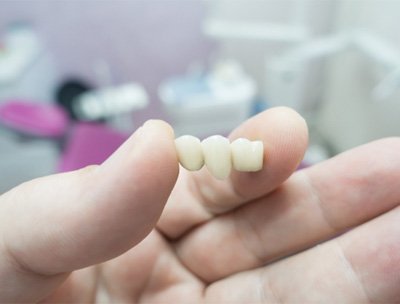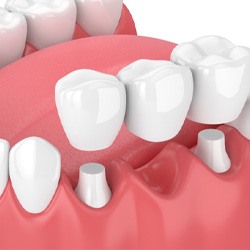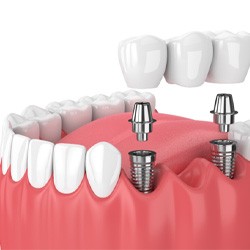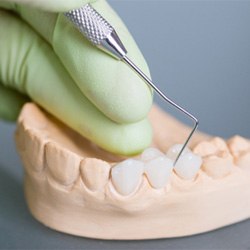Dental Bridges – Toledo, OH
Bridge the Gap in Your Grin

No one wants to be missing a tooth, but thanks to modern restorative dentistry you always have several smile solutions . When you are missing one or a few consecutive teeth but your teeth on either side of the gap are healthy, a dental bridge definitely merits consideration. At Dental Group West , count on our dentists to bridge the gap in your grin to restore its appearance and balance, plus this new addition will prevent dental drift and reduce your risk of gum disease. Contact your dentist in Toledo to schedule a consultation!
What Is a Dental Bridge?

Dental bridges are designed to help patients who are missing one tooth or several teeth in a consecutive row. An alternative to partial dentures, this tried-and-true tooth-replacement solution uses dental crowns or dental implants to secure the pontics (free-standing replacement teeth) in place. Since the materials used are available in a wide range of lifelike shades, modern dental bridges fill the gap in your smile seamlessly. Plus, they are incredibly durable, ensuring your bite doesn’t suffer either!
Types of Dental Bridges

The first step to regaining your primetime grin is a consultation with our experienced dentist . They’ll conduct an oral examination, ask about your goals, and review your medical history. Based on their findings, one of the following treatment options will be recommended:
Traditional Dental Bridge

A traditional dental bridge can replace a single missing tooth or several teeth in a row. This restorative treatment requires you to have a natural, stable adjacent tooth in front of and behind the space that you’re wanting to fill in. Essentially, we’re “bridging the gap” by making a single unit of three or more teeth.
Implant Bridge

As the name implies, an implant bridge uses dental implants as opposed to crowns. The implants are placed on either side of the gap in your smile, and after they’ve fused with the jawbone, we’ll be able to attach the dental bridge to the implants to replace two or more missing teeth. Considered the strongest and most stable system, an implant-supported bridge requires surgery to embed the implants into the jawbone. Your time invested in this option will pay off in the quality of the result!
The Benefits of Getting a Dental Bridge

When you replace your missing teeth with a dental bridge in Toledo, you can expect to enjoy an array of benefits including:
- Maintained alignment of your existing teeth
- Improved oral health
- Easy cleaning and maintenance
- Jawbone preservation with implant bridges
- Long-lasting results (15 years with traditional & 35+ with implant-supported)
- Natural-looking smile
Dental Bridges FAQs

Perhaps you’d like to get dental bridges in Toledo. After all, these prosthetics could do wonders for a smile with missing teeth! That said, learning basic facts about them is still a good idea. Doing so ensures you’ll receive the proper kind of care. Luckily, Dental Group West is here with some assistance: our staff has listed the answers to some popular bridge questions below. If you’d like, read them over to better grasp bridges’ qualities. For any other details you need, don’t hesitate to call us .
Is a Partial Denture the Same as a Bridge?
Simply put, no – a partial denture isn’t the same thing as a bridge. The two represent fairly different restorative dental treatments.
For starters, they contrast in removability. A partial denture is designed for easy removal at any time. Meanwhile, a bridge is made to stay in place for many years. As such, only a dentist can remove it from the mouth safely.
Furthermore, the two restorations don’t replace the same kinds of teeth. Partial dentures can substitute for non-consecutive ones at various points along an arch. However, a bridge can only replace missing teeth when they’re consecutive.
At your initial consultation, your dentist will review which tooth replacement suits your needs.
Are Dental Bridges Cheaper Than Implants?
Often enough, a traditional bridge does cost less than a dental implant. Still, the prices of both procedures vary in relation to multiple factors.
For example, implants are unique in that they require oral surgery. Consequently, you may have to pay specialist fees for the procedure. (You’d also need to pay for the implant posts themselves in addition to the restorations.) Bridges don’t need these specialists, though, and thus involve no such fees.
Similarly, implants usually aren’t covered by insurance. Most plans consider these prosthetics as somewhat over-the-top. In contrast, many dental policies will cover bridges to some extent.
What Can You Not Eat with a Dental Bridge?
Granted, dental bridges do let you chew most foods easily. Even so, you’d be wise to exercise caution around specific products. Your bridge will last longer that way.
Take sticky foods, for starters. Fruit gummies, caramel, and sticky candies could loosen your bridge. They could even pull it off your teeth if you aren’t careful! Therefore, try to avoid them as best you can.
While you’re at it, limit the number of sugary meals you have. High-sugar foods and drinks can decay the teeth supporting your bridge. You don’t need to give these things up entirely, but only have them in moderation. Plus, remember to drink water after eating such things.
Do Dental Bridges Look Natural?
Today, dental bridges look highly lifelike and natural. You can count on them to blend seamlessly with the rest of your smile.
You see, bridges use high-grade materials. Metal-free ones are made from ceramic and zirconia, which can be color-matched to your other teeth. Plus, they’re permanent in design and so won’t fall out.
Even metal bridges won’t be gaudy. While made from eye-catching gold and silver, they’re typically only used for teeth not visible in the smile.
